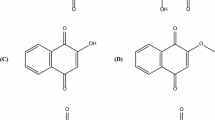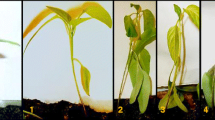Summary
The sesquiterpenes 2-(1',2'-dihydroxy-1'-methylethyl)-6,10-dimethyl-spiro-[4,5]dec-6-en-8-on (1) and its 2'-O-β-d-glucopyranoside (2) were isolated from the stress zones of potato tubers infected withPhoma foveata andFusarium spp., and rishitin and solavetivone from tuber slices inoculated withErwinia carotovora. The influence of these compounds, and of the naturally occurring plant sesquiterpenoids abscisic acid, cedrol and farnesol, on the mycelial growth ofPhytophthora infestans were tested on agar plates using a defined medium. All sesquiterpenoids suppressed the growth of the pathogen, except for1 and its glucoside2 which induced a slight, however significant, growth stimulation. Compounds1 and2 could not be isolated fromE. carotovora orP. infestans-inoculated tuber tissue.
Similar content being viewed by others
References
Ames, B.N., W.E. Durston, E. Yamasaki & F.D. Lee, 1973. Carcinogens are mutagens: A simple test system combining liver homogenates for activation and bacteria for detection.Proceedings of National Academic Science USA 70: 2281–2285.
Anderson, R., D.M. Gunn, J. Murray-Rust, P. Murray-Rust & J. Roberts, 1977. Vetispirane sesquiterpene glucosides from flue-cured Virginia tobacco.Journal of the Chemical Society. Chemical Communications: 27–28.
Arnoldi, A. & L. Merlini, 1990. Lipophilicity-antifungal relationships for some isoflavonoid phytoalexins.Journal of Agricultural and Food Chemistry 38: 834–838.
Beczner, J. & T. Ersek, 1976. Fungitoxicity of phytoalexins derived from potato against mycelial growth ofPhytophthora infestans.Acta Phytopathologica Accademiae Scientiarum Hungaricae 11: 59–64.
Berggren, B., A.-K. Widmark & V. Umaerus, 1988. The expression of general resistance to late blight (Phytophthora infestans) in potato leaves.Potato Research 31: 611–616.
Brishammar, S., 1987. Critical aspects of phytoalexins in potato.Journal of Agricultural Sciences in Finland 59: 217–230.
Coxon, D.T., K.R. Price, B. Howard & R.F. Curtis, 1977. Metabolites from microbially infected potato.Journal of the Chemical Society, Perkin Transactions I, Part 1: 53–59.
Dictionary of Natural Products, 1994. Chapman & Hall, London.
Doke, N., N. Garas & J. Kuc', 1979. Partial characterization and aspects of the mode of action of a hypersensitivity-inhibiting factor (HIF) fromPhytophthora infestans.Physiological Plant Pathology 15: 127–140.
Gerwig, G.J., J.P. Kamerling & J.F.G. Vliegenhart, 1978. Determination of the D and L configuration of neutral monosaccharides by high-resolution capillary GLC.Carbohydrate Research 62: 349–357.
Harborne, J.B. & J.L. Ingham, 1978. Biochemical aspects of the coevolution of higher plants and their fungal parasites. In: J.B. Harborne (Ed.), Biochemical Aspects of Plant and Animal Coevolution. Academic Press, London, pp. 343–405.
Harris, J.E. & C. Dennis, 1976. Antifungal activity of post-infectional metabolites from potato tubers.Physiological Plant Pathology 9: 155–165.
Hohl, H.R., 1975. Levels of nutritional complexity inPhytophthora: Lipids, nitrogen sources and growth factors.Phytopathological Zeitung 84: 18–33.
Hohl, H.R., P. Stössel & H. Hächler, 1980. Papillae formation and partial inhibition of fungal glucanases by phytoalexins in thePhytophthora infestans-Solanum tuberosum system.Annual Phytopathology 12: 353–362.
Hwu, J.R. & J.M. Wetzel, 1992. Silicon-promoted ring contractions in the formation of carbocyclic spiro compounds. Total synthesis of (−)-solavetivone.Journal of Organic Chemistry 57: 922–928.
Ishiaka, J., K. Tomiyama, N. Katsui, A. Murai & T. Masamune, 1969. Biological activities of rishitin, an antifungal compound isolated from diseased potato tubers and its derivatives.Plant and Cell Physiology 10: 183–192.
Kodama, H., T. Fujimori, H. Tanaka & K. Kato, 1985. Antibacterial activity of sesquiterpeniod stress compounds and their glycosides from tobacco.Agricultural and Biological Chemistry 49: 1527–1528.
Kuc', J., 1995. Phytoalexins, stress metabolism, and disease resistance in plants.Annual Review of Phytopathology 33: 275–297.
Laks, P.E. & M.S. Pruner, 1989. Flavonoid biocides: structure/activity relations of flavonoid phytoalexin analogs.Phytochemistry 28: 87–91.
Lyon, G.D., B.M. Lund, C.E. Bayliss & G.M. Wyatt, 1975. Resistance of potato tubers toErwinia carotovora and formation of rishitin and phytuberin in infected tissue.Physiological Plant Pathology 6: 177–186.
Malmberg, A. & O. Theander, 1980. Two phytoalexin glycosides from potato tubers infected withPhoma.Phytochemistry 19: 1739–1742.
Mosch, W. & J. Mooi, 1975. A chemical method to identify tuber rot in potato caused byPhoma exigua var.foveata.Netherlands Journal of Plant Pathology 81: 86–88.
Sato, N., Y. Yoshizawa, H. Miyazaki & A. Murai, 1985. Antifungal activity toPhytophthora infestans and toxicity to tuber tissue of several potato phytoalexins.Annual Phytopathological Society of Japan 5: 494–497.
Smith, D.A., 1982. Toxicity of phytoalexins. In: J.A. Bailey & J.W. Mansfield (Eds), Phytoalexins. Blackie, Glasgow, pp. 218–252.
Smith, C.J., 1996. Accumulation of phytoalexins: defence mechanism and stimulus response system.New Phytologist 132: 1–45.
Stössel, P. & H.R. Hohl, 1981 Effect of phytoalexins on hyphal growth and b-glucanases ofPhytophthora infestans.Mycopathologia 73: 153–159.
Tanaka, H., R. Uegaki, T. Fujimori & K. Kato, 1983. Antibacterial activity of sesquiterpenoid from tobacco leaves elicited byPseudomonas solanacearum and Tobacco Mosaic Virus.Annual Phytopathological Society of Japan 49: 501–507.
Umaerus, V., 1976. Rötsvamparnas biologi och förutsättningar för resistensförädling.Växtskyddsnotiser 4: 9–15.
Author information
Authors and Affiliations
Rights and permissions
About this article
Cite this article
Engström, K., Widmark, A.K., Brishammar, S. et al. Antifungal activity toPhytophthora infestans of sesquiterpenoids from infected potato tubers. Potato Res 42, 43–50 (1999). https://doi.org/10.1007/BF02358390
Accepted:
Issue Date:
DOI: https://doi.org/10.1007/BF02358390




